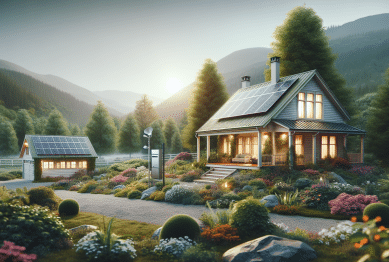Discover how smart home gardening is helping people grow fresh produce and beautiful plants indoors and outdoors, all while saving time and resources. This guide explores setup, technology, plant choices, and how automation is reshaping everyday gardening experiences for homes of all types.
Getting Started With Smart Home Gardening
Smart home gardening is transforming the way people interact with green spaces at home. Once limited to those with yards or large balconies, gardening is now accessible even to apartment dwellers and busy households thanks to connected devices, modular planters, and automated systems. By blending technology with natural growth cycles, these systems allow nearly anyone to cultivate fresh herbs, vegetables, or decorative plants indoors and outdoors.
Although many beginners hesitate because of limited space or lack of experience, modular vertical gardens and compact hydroponic units show that almost any area can support thriving plants. Even without prior gardening knowledge, individuals can now grow basil in the kitchen, strawberries on the balcony, or succulents in a corner under LED grow lights. The rise of smart home gardening proves that cultivating greenery is no longer restricted to those with time, expertise, or large gardens—it has become an accessible, customizable lifestyle choice.
Planning Your First Smart Garden
Getting started requires some thoughtful planning. The first step is choosing the right location. A sunny windowsill, a shaded balcony, or even an unused corner with LED grow lights can become a functional gardening zone. Because light and airflow vary from one space to another, assessing these conditions in advance helps you decide which system will work best.
Next, select the type of smart gardening setup that fits your lifestyle. Busy professionals might appreciate self-watering pots or fully automated irrigation systems that adjust moisture levels automatically. Families may prefer climate-controlled mini-greenhouses that allow children to participate in gardening while keeping plants protected. Tech enthusiasts often gravitate toward sensor-monitored planters that track humidity, soil pH, and nutrient balance. Since most devices now connect to mobile apps, monitoring progress and receiving care reminders is easier than ever.
Once the basics are in place, consider what you want to grow. Herbs like mint, thyme, and parsley require little space and offer quick, rewarding results. For those who enjoy salads, leafy greens such as spinach or arugula grow fast and can be harvested multiple times. If you prefer something more ambitious, compact systems even support fruiting plants like cherry tomatoes and strawberries. By customizing soil type, nutrient levels, and humidity, most smart systems adapt to your plant preferences (see University of Minnesota Extension).
Innovative Technology Powering Smart Gardens
Technology lies at the heart of smart home gardening, and it dramatically simplifies plant care. For example, wireless sensors track soil moisture, sunlight, and temperature, sending data directly to your phone or smart hub. As a result, you know exactly when your plants need attention. Because many platforms integrate with voice assistants, you can ask for real-time updates hands-free while cooking or working.
Automated irrigation is one of the most valuable features. Systems equipped with drip lines or smart watering bulbs release the right amount of water based on sensor readings. Instead of watering on a fixed schedule, they adjust to actual plant needs and seasonal shifts. Mixed gardens benefit especially from this flexibility, since herbs, flowers, and vegetables often require different watering levels.
Lighting and nutrition have also been transformed. Smart LED grow panels replicate daylight cycles, enabling growth in spaces with little or no natural light. Nutrient delivery kits, paired with app-based analysis, ensure plants receive the right balance of minerals at the right time. Because of these innovations, home-grown produce is now possible year-round—even in urban apartments with no outdoor space (see U.S. Department of Energy).
Ideal Plant Choices for Indoor and Outdoor Systems
Choosing the right plants helps maximize your smart garden investment. Leafy greens like kale, spinach, and lettuce are excellent for beginners, as they grow quickly and tolerate modest light. Herbs such as basil, cilantro, and rosemary thrive in compact systems and can be harvested continuously. For variety, cherry tomatoes, dwarf peppers, or strawberries add color and taste, making them popular among smart garden users.
Outdoor smart gardens expand the range of possibilities. Peppers, carrots, and bush beans adapt well to automated irrigation and natural sunlight. Flowers like zinnias or marigolds brighten spaces while attracting pollinators. By connecting weather sensors, these systems automatically adjust care during droughts, frost, or heavy rains, ensuring resilience.
Hybrid systems also allow gardeners to combine decorative and edible plants. For instance, one tier may hold tomato vines while another displays trailing ivies or ferns. This creates visual appeal while diversifying crops, reducing pests, and optimizing available resources (see University of Arkansas Extension).
Benefits Beyond Convenience
Smart home gardening offers more than simplified plant care—it improves daily life. Research shows that living with plants reduces stress, boosts focus, and improves indoor air quality by filtering pollutants. Because automated systems maintain consistent care, plants remain lush, creating a calming and aesthetically pleasing environment.
There are financial benefits as well. Growing fresh herbs, salad greens, or specialty vegetables often reduces grocery bills, especially since these items can be costly in stores. By harvesting small amounts regularly, you avoid food waste while supplementing weekly meals with home-grown produce. Over time, the investment in a smart garden often pays for itself through savings.
From an environmental perspective, smart gardens encourage more sustainable practices. Efficient irrigation systems reduce water waste, and energy-saving LED panels minimize electricity use. Furthermore, composting and organic nutrient kits reduce reliance on chemical fertilizers. By learning to monitor resources through apps and sensors, gardeners develop greater awareness of how consumption impacts the environment (see EPA Green Gardening).
Common Challenges and Smart Solutions
Like all gardens, smart systems face occasional challenges. Pests, mold, or nutrient imbalances can affect plant health. However, connected sensors provide timely alerts, reminding you to refill water tanks, check pH levels, or adjust light cycles. Some apps even allow photo uploads for instant feedback on plant health, suggesting natural remedies rather than chemical solutions.
Pest control has improved with innovations such as ultrasound deterrents or smart traps that protect plants without pesticides. Meanwhile, integrated cameras help track growth and detect issues early. Because automation takes care of the daily routines, gardeners have more time to observe, learn, and enjoy their plants.
For those with busy schedules or frequent travel, remote monitoring provides reassurance. A quick check on your phone shows soil moisture, water tank levels, or upcoming irrigation cycles. Automation ensures continuity of care, so plants thrive even during your absence (see Rutgers Home & Garden).
Future Trends and Expanding Potential
The future of smart gardening looks even more innovative. Artificial intelligence now plays a role in predicting pest outbreaks, recommending planting schedules, and diagnosing plant diseases through image recognition. Voice integration allows instant updates, while app-based communities encourage sharing advice and data with fellow gardeners.
Sustainability continues to guide development. Expect to see solar-powered devices, water recycling features, and biodegradable containers becoming standard. On a community scale, rooftop smart gardens and urban agriculture initiatives are creating shared growing spaces in dense cities. These systems not only produce food locally but also encourage collaboration and education.
Accessibility is also improving. Developers are designing affordable starter kits with user-friendly apps to attract beginners. As prices decrease and compatibility with existing smart home devices expands, more households will adopt this technology (see NY Agriculture).
References
1. University of Minnesota Extension. (n.d.). How to start an indoor garden. Retrieved from https://extension.umn.edu/how/start-indoor-garden
2. U.S. Department of Energy. (n.d.). Indoor agriculture technology. Retrieved from https://www.energy.gov/eere/buildings/articles/indoor-agriculture-technology
3. University of Arkansas System Division of Agriculture. (n.d.). Indoor gardening. Retrieved from https://uaex.uada.edu/yard-garden/vegetables/indoor-gardening.aspx
4. U.S. Environmental Protection Agency. (n.d.). Green gardening and composting. Retrieved from https://www.epa.gov/smm/green-gardening
5. Rutgers New Jersey Agricultural Experiment Station. (n.d.). Home, lawn, and garden. Retrieved from https://njaes.rutgers.edu/home-lawn-garden/
6. New York State Department of Agriculture. (n.d.). Indoor and urban gardening guidance. Retrieved from https://www.agriculture.ny.gov/Indoor-Urban-Gardening









